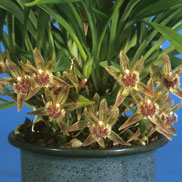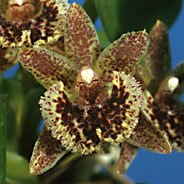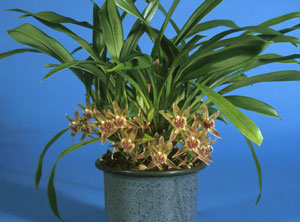

by Marni Turkel / Originally Published in Orchids Magazine
| Hybrid Flask List |
| Orchid Programs |
The genus is distributed from southern Mexico to Bolivia. Plants are compact, with fan-shaped growths comprising soft leaves usually not taller than 8 inches (20 cm). Even though they are related to the widely grown Zygopetalum, Kefersteinias do not have pseudobulbs, but they do have surprisingly thick, succulent roots that help them through dry periods. On a well-grown plant, these roots can be exuberant and literally push the plant out of the pot. Most are epiphytic cloud-forest plants found at elevations between 3,280 and 6,562 feet (1,000–2,000 m) making them well suited to cool and intermediate growing conditions. There are also some lower-elevation species adapted to warmer temperatures. The flowers are produced by both recently matured and older growths and can ring the base of the plant for a wonderful display.
|
HISTORY The first Kefersteinia species was described in 1852, but the majority of the 60 or so species of this genus have been published within the last 20 years. However, not all of these are newly found species; some have been in cultivation for many years but mislabeled because many species of Kefersteinia are similar and easily confused. A case in point is Kefersteinia koechlinorum, which is illustrated here. I purchased a division of this plant in 1987 as Kefersteinia lojae from a nursery in California and grew it as that until 2000 when Eric Christenson, PhD, described the species from a plant growing at 6,562 feet (2,000 m) on the property of the Machu Picchu Pueblo Hotel, in the Department of Cusco, Peru.
CULTURE A moisture-retentive medium that does not become soggy is ideal for potted Kefersteinias. A fine-grade epiphytic bark mix such as four or five parts washed and sifted fine fir bark and one part perlite will work. I also usually add some tree-fern fiber and charcoal to open up the mix a bit. New Zealand sphagnum moss in plastic, ceramic or net pots is another choice. One should adjust watering cycles as necessary to maintain even moisture.
 |
| Kefersteinia aurorae |
Mounted plants of Kefersteinia display their flowers beautifully but can be difficult to maintain. Steve Beckendorf, a grower in the San Francisco Bay Area, grows mounted plants to perfection in his cool greenhouse. He attaches a small piece of cork onto a larger piece of cork and positions the plant on the little ledge that simulates the crotch of a tree branch. Fertilize regularly with a half-strength solution in spring and summer and less often in autumn and winter. Be sure to periodically flush pots well with water.
The proper temperature range will be determined by the elevation at which the plants naturally occur. Plants such as the species illustrated here are cool growers and do best with a temperature range from 50 to 55 F (10–13 C) as the minimum winter night and 75 F (24 C) as the average day time temperature. Grow Kefersteinias in moderate light where a hand held 12 to 18 inches (30.5–46 cm) above the plant casts a diffuse shadow.
Divide and repot plants as a new growth is emerging so that the new roots can go into fresh medium. While a single growth division can grow well, a piece with three or four growths is preferable. Adequate humidity and plenty of air movement will go a long way toward growing healthy plants.
The only time I have had a general problem growing them was after the local water company started adding sodium hydroxide to raise the pH of the water, and the sodium had a deleterious effect. All of my plants of Kefersteinia started a slow decline that worsened until I installed a reverse-osmosis water system. After repotting the plants with fresh medium to remove the built-up salts, the plants started thriving again.
References
Christenson, E.A. 2000. A new Kefersteinia from Cusco, Peru. Orchid Digest 64(3):139–141.
__. 2002. The Genus Kefersteinia. Orchid Digest 66(3):110–114.
Mostly Species / Orchids and Flasks | Santa Rosa, CA 95407
© Marni Turkel 2003-2022 All rights reserved
